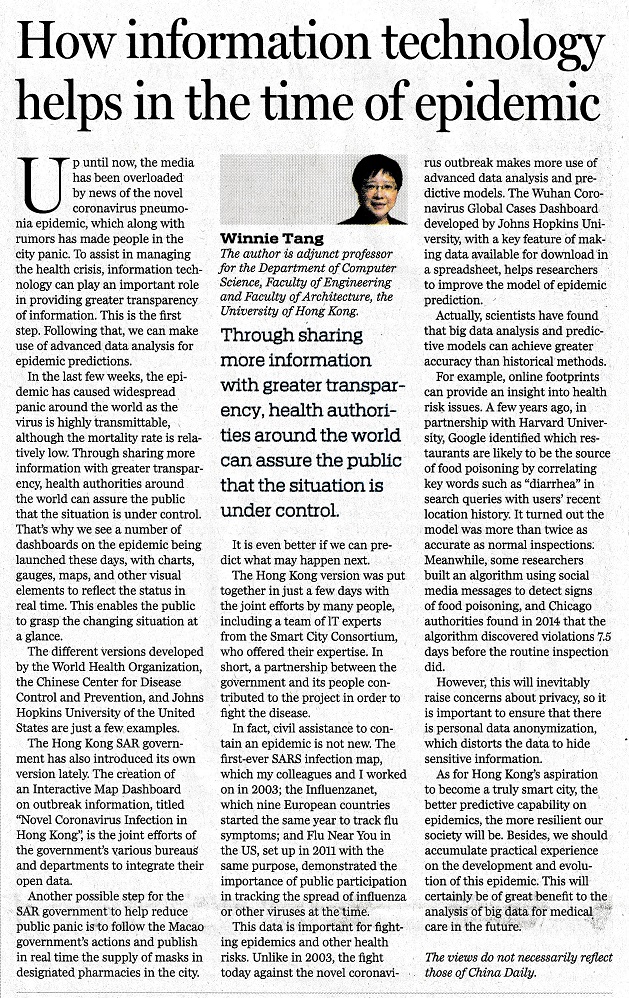網上版請按此

How information technology helps in the time of epidemic
Through sharing more information with greater transparency, health authorities around the world can assure the public that the situation is under control.
Up until now, the media has been overloaded by news of the novel coronavirus pneumonia epidemic, which along with rumors has made people in the city panic. To assist in managing the health crisis, information technology can play an important role in providing greater transparency of information. This is the first step. Following that, we can make use of advanced data analysis for epidemic predictions.
In the last few weeks, the epidemic has caused widespread panic around the world as the virus is highly transmittable, although the mortality rate is relatively low. Through sharing more information with greater transparency, health authorities around the world can assure the public that the situation is under control. That's why we see a number of dashboards on the epidemic being launched these days, with charts, gauges, maps, and other visual elements to reflect the status in real time. This enables the public to grasp the changing situation at a glance.
The different versions developed by the World Health Organization, the Chinese Center for Disease Control and Prevention, and Johns Hopkins University of the United States are just a few examples.
The Hong Kong SAR government has also introduced its own version lately. The creation of an Interactive Map Dashboard on outbreak information, titled "Novel Coronavirus Infection in Hong Kong", is the joint efforts of the government's various bureaus and departments to integrate their open data.
Another possible step for the SAR government to help reduce public panic is to follow the Macao government's actions and publish in real time the supply of masks in designated pharmacies in the city.
It is even better if we can predict what may happen next.
The Hong Kong version was put together in just a few days with the joint efforts by many people, including a team of lT experts from the Smart City Consortium, who offered their expertise. In short, a partnership between the government and its people contributed to the project in order to fight the disease.
In fact, civil assistance to contain an epidemic is not new. The first-ever SARS infection map, which my colleagues and I worked on in 2003; the Influenzanet, which nine European countries started the same year to track flu symptoms; and Flu Near You in the US, set up in 2011 with the same purpose, demonstrated the importance of public participation in tracking the spread of influenza or other viruses at the time.
This data is important for fighting epidemics and other health risks. Unlike in 2003, the fight today against the novel coronavirus outbreak makes more use of advanced data analysis and predictive models. The Wuhan Coronavirus Global Cases Dashboard developed by Johns Hopkins University, with a key feature of making data available for download in a spreadsheet, helps researchers to improve the model of epidemic prediction.
Actually, scientists have found that big data analysis and predictive models can achieve greater accuracy than historical methods.
For example, online footprints can provide an insight into health risk issues. A few years ago, in partnership with Harvard University, Google identified which restaurants are likely to be the source of food poisoning by correlating key words such as "diarrhea" in search queries with users' recent location history. It turned out the model was more than twice as accurate as normal inspections. Meanwhile, some researchers built an algorithm using social media messages to detect signs of food poisoning, and Chicago authorities found in 2014 that the algorithm discovered violations 7.5 days before the routine inspection did.
However, this will inevitably raise concerns about privacy, so it is important to ensure that there is personal data anonymization, which distorts the data to hide sensitive information.
As for Hong Kong's aspiration to become a truly smart city, the better predictive capability on epidemics, the more resilient our society will be. Besides, we should accumulate practical experience on the development and evolution of this epidemic. This will certainly be of great benefit to the analysis of big data for medical care in the future.
Dr. Winnie Tang
Adjunct Professor, Department of Computer Science, Faculty of Engineering and Faculty of Architecture, The University of Hong Kong
The views do not necessarily reflect those of China Daily.